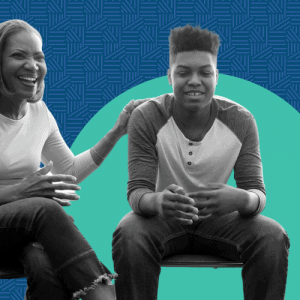
Overcoming Math Anxiety
04/27/2023

Normalizing Struggle to Promote Confidence in Mathematics
Math is all around us. It allows us to make sense of our world. But too few people finish their K-12 journey feeling ready to apply mathematical thinking to everyday problems. So, what can we do about it?
Earlier, I talked with Rachel Scarpato, Senior Director of Math Strategy at Leading Educators, about the importance of students feeling like they belong in the classroom. Leaning into students’ strengths so they see everyone has the potential to be a mathematician is a crucial element of their math experience.
As our conversation continues, Rachel shares ways teachers can help alleviate math anxiety—worry, fear or avoidance of math —and sharpen their focus toward access in the classroom.
MATH ANXIETY IS NORMAL
LT: We know that math anxiety is something that affects many students and can carry over into adulthood. 93% of adults say they experience some form of math anxiety. How can teachers help students combat that anxiety starting at a young age?
RS: I think the first thing is normalizing the struggle and feelings of math anxiety for students.
We’re all going to learn things, and sometimes the process is going to be hard. Sometimes it’s not going to come easily to us, and that’s okay. We’re here to support each other, and we’re going to be working together and working independently.”
In addition to normalizing the struggle, I’d recommend being mindful of how much math work a teacher is giving that is timed or evaluative. Anything that’s timed or evaluative must serve a clear and compelling purpose and students should know what that purpose is.
Another thing to consider is asking students if this anxiety is something they experience. Hearing from them and asking, “If this is happening, what is going on in your body?” is very helpful. Get them to recognize when they are feeling anxious so you can give them strategies for what to do.
For example, if you’re feeling anxious, you can go back and look at your notebook. You can talk to a classmate, or you can look at a study guide. Be explicit about teaching what to do when kids are in that panic state of, “I don’t know what to do, and I feel kind of frozen.”
MATH ANXIETY, ACCESS, BELONGING, AND SELF-IDENTITY ARE CONNECTED
LT: Learning how to handle those emotions goes along with a more holistic approach to teaching because it’s not just about teaching the material; it’s also about teaching them how to regulate their emotions and different ways that they can do that. Those skills will translate not just in the classroom, but to other areas of your life once you leave the classroom.
RS: I think that’s another example of how math and equity and social-emotional learning connect. We know math anxiety is real. We know students experience it, and we know adults have experienced it. So, that’s a clear example of the intersection of all those factors and supporting students as they navigate through that anxiety.
SEEING STUDENTS’ STRENGTHS INCREASES EQUITY
LT: You mention how math anxiety and equity connect, but I think it can be hard for many people to understand what math equity is. If you’re thinking about just numbers, it seems clear…you’re either learning the material or you’re not. But it’s more complicated than that. I’d love to hear a little bit about what equity in math is and why it’s important.
RS: Certainly, things like belonging and access, who has access to what classes, who is gaining access to the STEM field and STEM careers; whose math class is acting as a gatekeeper, who is getting told, “Hey, if you take this class, you’re going to get a C.” Those are issues of equity right there.
Beliefs and mindsets are being held by individuals or by a system that is being communicated to people, to students, to teachers, and they’re internalizing them; that leads to them thinking differently about themselves and what they’re capable of. At Leading Educators, I think we’ve evolved in this thinking. Previously, our professional learning sessions tended to do math learning that focused on unpacking standards, understanding the Common Core shifts, and learning different strategies that are embedded in the curriculum. This is important, but that was separate from the equity work we did around what biases you are bringing to the table. What is happening in your classroom? What messages do you think students are getting? Those were seen as separate things.
Now, when we talk about math and equity, we’re bringing those things together. It’s thinking not just about the content, but how is my delivery of the content? As an educator, how am I showing up in class? What messages am I sending? Who’s participating in math class? Who’s not participating in math class? It’s giving this awareness to the day-to-day teaching that really has an impact on how students show up and what students believe about themselves.
That equity piece is important because there are a lot of misconceptions about math, and unfortunately, a lot of the misconceptions that exist center on certain people being weeded out of math. So, if we know that to be true, we need to think critically about how we make math a more open space, a more inviting space, and a more equitable space for everyone.
STUDENTS ARE THE BEST SOURCE OF INFORMATION
LT: For teachers who don’t have professional development support or a high-quality curriculum at their disposal, what are some ways they can make their math classes a little more accessible and equitable? Are there tools or strategies that they can use that can help them with that in the classroom?
RS: One thing that comes to mind is thinking about your own experience with math. What was your math journey? What were the peaks and valleys, then also think about the intersections with elements of your identity. It’s a good exercise to think about, “Okay, what have I gone through? How is this impacting how I’m showing up in class, and what messages I’m communicating?”
I also think talking to students is a great source of information. Have them fill out a survey asking, “What is math?”. Doing word associations of what math means to them would be interesting information to get. Asking students about their experience with math, and how they feel about themselves as math learners. If you know that you have students who are expressing that they have math anxiety, or are expressing that they are feeling like they are not a math person, or expressing that, hey, how we’re learning in class is different from how my parents are teaching me at home, that is all critical information.
Those are the things that are top of mind for me…tapping into what students are telling you and hearing from them. Before you think, “Oh, no, I need to overhaul and change all this stuff I’m doing,” hearing what they’re saying and starting small with, “Today I’m ensuring there’s more equal distribution of who is communicating or who is sharing their answers in class.”
USING MATH TO SOLVE COMMUNITY CHALLENGES
LT: In Teaching for Equity, LE’s framework for strengthening student experiences, one of the classroom strands looks at how the instructional content makes relevant, representative connections between the students’ lives, their local community, and the broader world. There are common ways that idea shows up in an English class, but when we’re talking about relevant and representative connections, how does that show up in a math class?
RS: I think that’s an idea that’s currently untapped in the math space, which is why I think it’s important to name and ask guiding questions specifically around that topic. ELA has the potential to make those relevant connections in the texts that are read or the topics that are discussed. But there are ways to hold a math class that makes students think, “I can bring what I know about myself, about my family, about my community into the classroom. It is an asset to this space that I’m in.”
I think an example I’ve seen is a website called Ed Gap, where you can look at a map of the US and zoom in by zip code. It shows what the median SAT or ACT scores are in that area. It also gives you information about the median household income. This is a way to bring in math, bring in connections to statistics, and data that are meaningful for students to think about in terms of what is going on where I live. What’s going on maybe a little bit more broadly, what’s going on nationally? That’s an example of what a math class could look like and how to make math meaningful to people, teachers included, and to students.
I’m just really excited for the day when making those connections is just what we do in math. We look at problems affecting our community, and we use math as a tool to understand the problems more deeply and work toward a solution.
Take Action
Are you looking for support with your district’s math strategy? Get in touch with us about opportunities to partner.







